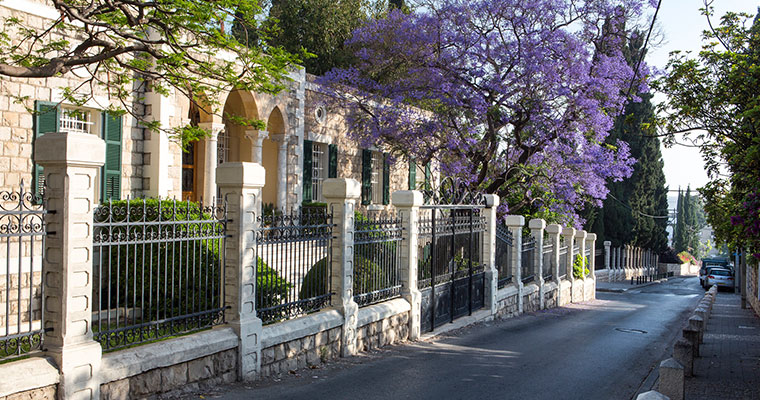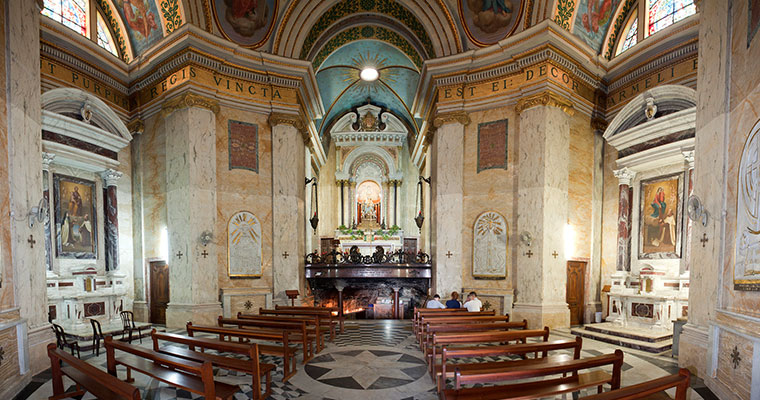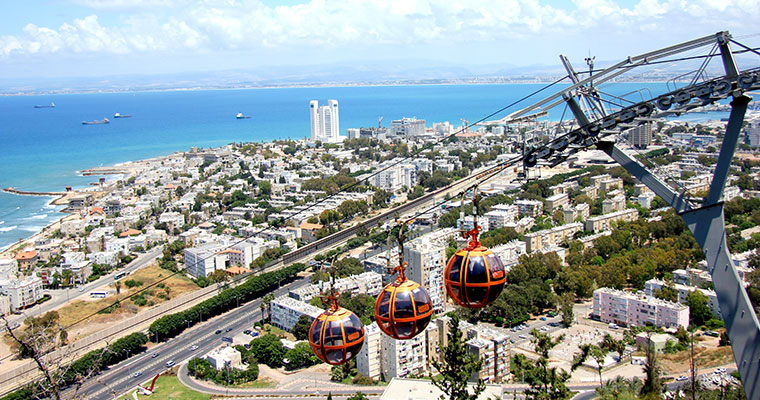Haifa – The city that thrives with diversity
Lee Saunders 28/05/2017
“Climb mountains, – not so that the world can see you, but so you can see the world.” Never is this truer than in Israel’s third largest city, Haifa, built on the slopes of Mount Carmel.
The incredible views from this mountain range shine a light on a bustling port city, sandwiched between the mountains and the Mediterranean Sea.
In this blog, we catch a metaphorical cable car over the main areas to bring you a city brimming with diversity, proud of its history and serving up fascinating attractions, all a short distance from the Dan Carmel Haifa and Dan Panorama Haifa.
A UNESCO World Heritage site that must be seen
One of Haifa’s most-photographed attractions is the city’s astonishingly manicured Baha’i Gardens, a stunning UNESCO World Heritage site, known as one of the two holiest sites for the Baha’i Faith, a ‘young’ religion emanating from 19th century Persia.
Book your next vacation at Dan Hotels in Haifa >>
Pulling in close to a million visitors yearly, you can learn about their fascinating beliefs, values and spirituality on a free guided tour, and gently walk down the 19-terrace (only 1km!) staircase to capture spectacular views of the golden-domed Shrine of the Báb, a founder of the faith, looking downwards towards the German Colony, not forgetting to look back upwards towards the northern slopes of Mount Carmel.
Mercaz HaCarmel contains impressive historical and cultural gems
Weaving behind the Baha’i Gardens via HaNassi Boulevard brings you quickly to the Mercaz HaCarmel, a prestigious residential neighborhood containing the luxurious Dan Hotels, as well as impressive historical and cultural gems.
As you take a leisurely stroll, there is an unexpected artistic joy to behold in the form of the Tikotin Museum of Japanese Art, established almost 60 years ago to build and develop stronger relations between Israel and Japan.
Exploring Japanese art work from the 17th century to modern day, the museum is a genuine revelation with more than 7,000 exhibits. Further down HaNassi Boulevard, past Haifa Zoo, and you will come to the Haifa Auditorium and the Haifa Cinematheque, two of the venues in the
city’s popular international film festival pulling in more than 400,000 movie fans every October.
If you are looking for tasty cuisine and a well-stocked bar to quench your appetite, look no further than the nearby Sleek, and the string of bars and restaurants as it winds into Moriya Boulevard, one of Haifa’s liveliest nightlife spots.
German Colony remembers a complex past and vibrant present
At the foot of the Baha’i Gardens, towards the sea, is Haifa’s picturesque German Colony. By the end of the 19th century, the German Templars, a Protestant branch of Christianity, were well established in Haifa, as they were in Tel Aviv and Jerusalem.
Today, the Haifa City Museum stands where the Templars’ former community hall had been, and remembers a complex past and vibrant present. While embracing its traditions – some of the old Templar homes have undergone restorations – the German Colony has become home to many trendy red-roofed cafés, boutiques and restaurants, especially on the lively Ben Gurion Boulevard.
Consider trying Shtroudl, an excellent venue for high quality Mediterranean and Middle Eastern dishes, and Douzan, one of the best and most ambient places for delicious meat on a menu just bursting with flavor.
Melting pot of all tastes and flavors
Around a kilometer from the German Colony is Hadar HaCarmel, once Haifa’s commercial center, and today a thriving melting pot of all communities, underlining Haifa’s unique multicultural vibes.
Streets are lined with Bauhaus buildings, designed by German-Jewish architects, refugees from war-torn Europe, while the delightful neighborhood of Wadi Nisnas, Haifa’s best known Arab residential area, greets visitors with a colorful and welcoming market brimming with a variety of pita bakeries, falafel stores and restaurants, such as Ein El Wadi, which serves authentic Lebanese and Arabic food.
This district also hosts cultural landmarks, such as Beit HaGefen, an Arab–Jewish cultural center set up in 1963, and The Haifa Museum of Art, one of Israel’s many great art museums, on the edge of Wadi Nisnas, and housing contemporary Israeli and international art exhibits.
Close by, there is another more alternative and impressive art form on display at Masada Street, where cool graffiti decorates the walls between the retro music stores, cute cafés and quirky antique shops that make this one of Haifa’s charmingly hip neighborhoods.
Creativity and innovation are close companions throughout Haifa, and in Hadar HaCarmel, the Madatech- Israel National Museum of Science, Technology and Space inspires visitors with a raft of scientific and technological secrets and discoveries.
Madatech sits on the original home of the iconic Technion University, the country’s first academic institution established over a century ago, and has set a high bar among science museums worldwide. It is also well worth a visit to the current home of the Technion which best epitomizes Haifa’s, and Israel’s, contributions to the field of science and innovation, meanwhile the University of Haifa sits proudly on top Carmel Mountain, close to the wondrous Carmel Forest.
Close to the Carmel Forest, there are a number of Druze villages, who showcase Haifa’s broad diversity in a wonderful light. Recognized as a distinct ethnic community in Israel, the Druze, who numbered around 130,000 in 2012, have preserved their traditions and customs.
Visit the small towns of Daliyat el-Carmel and Isfiya, well worth a short day trip from Haifa. Browse through markets selling traditional Druze and Arab trinkets, before settling down to tasty lamb, chicken and rice dishes cooked to perfection at authentic Druze restaurants, including the wonderfully hospitable Nurah’s Kitchen and Nof Carmel.
Stella Maris – where the sea stares right back
While Druze villages dot one side of the Mount Carmel landscape, Elijah’s Cave stands at the other end. Enshrined by a domed chapel, the cave served as the home of one of the renowned prophets, back in 9th century BC.
A visit there is an oddly moving and incomparable experience that leaves you reflective of the life and times of a man, whose simple cave was rich with so many historic tales. Sacred to Jews, Muslims, Druze and Christians, one tradition holds that Mary, Joseph and Jesus found shelter in this cave for a night on their return from Egypt.
While Druze villages dot one side of the Mount Carmel landscape, on the other end stands the architectural marvel that is the Stella Maris Carmelite Monastery, one of the largest and most significant churches in Haifa for the Carmelites, a Catholic religious order founded on Mount Carmel in the 12th century.
Set up in 1836, take a walk through the monastery’s stunning main hall, which, in its heyday, included a medical center, a pharmacy and an inn. Sheltering just behind the monastery is a delightfully surreal coffee shop, Santa Maria, dishing up authentic Austrian food, from sausages to Viennese pastries, as you look out and soak up the view of Haifa Bay.
And from this corner of Haifa, the sea stares right back. The nearby National Maritime Museum takes visitors on a fascinating voyage, explaining the deep connection between locals and the Mediterranean Sea, beaches and ports, while, next door, the Clandestine Immigration and Navy Museum is a must see stop for adults and kids gripped by all things naval.
The museum impresses for its collection of maps, photos and artefacts relating to immigration during the British Mandate period.
Close by, the Haifa Stella Maris Cable Car Station takes you on a swift and eye-popping cable car ride with tremendous views of the seascape below – from the monastery, on top of the Carmel ridge, right down to the sandy beaches and promenade at Bat Galim, meaning Daughter of the Waves in Hebrew.
From here, you can enjoy a wide variety of cafés and restaurants, while listening to the waves crash gently against the Mediterranean shore and breathing in the diverse city that is Haifa.





